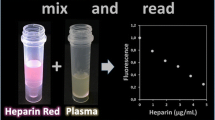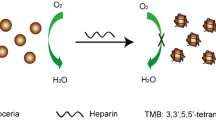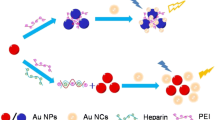Abstract
Methylene blue (MB) is one of the most common cationic dyes to detect heparin. As the sulfate residue presented in heparin was the main contributor to bind with MB, the UV performance of the MB with selectively desulfated heparin derivatives was investigated. It was found that the sulfate residue in different heparin analogues did not show the equal ability to attract MB binding. The stoichiometry of sulfate with MB among the heparin and derivatives was verified as a non-constant number. For the two selectively desulfated heparin derivatives: sulfate elimination at 6-O (6-OdeS) and N-acetylated heparin (N-deS-Acetyl), the MB to sulfate ratios were significantly higher than for heparin. For the not fully diminished sulfate at 2-O heparin derivative (2-OdeS), the MB-SO3- ratio of 2-OdeS was between 6-OdeS, N-deS-Acetlyl and heparin. Although in a distinct sulfation position, the MB-SO3- ratio of 6-OdeS and N-deS-Acetyl was almost equal, which agreed with the comparable total desulfation degree between 6-OdeS and N-deS-Acetyl. In addition, compared to heparin groups, the non-desulfated gs-HP showed no significantly different MB-SO3- ratio with heparin. The above results demonstrated that compared with the sulfate location and glycan composition of heparin, the content of sulfate was the most essential factor for the MB binding.






Similar content being viewed by others
References
Barrowcliffe, T.W.: History of heparin. Handb. Exp. Pharmacol. 3–22 (2012). https://doi.org/10.1007/978-3-642-23056-1_1
Harenberg, J.: Past, present, and future perspectives of heparins in clinical settings and the role of impaired renal function. Int. J. Cardiol. 212, 10–13 (2016). https://doi.org/10.1016/s0167-5273(16)12003-0
Hirsh, J.: Heparin. N. Engl. J. Med. 324, 1565–74 (1991). https://doi.org/10.1056/nejm199105303242206
Esko, J.D., Selleck, S.B.: Order out of chaos: assembly of ligand binding sites in heparan sulfate. Annu. Rev. Biochem. 71, 435–71 (2002). https://doi.org/10.1146/annurev.biochem.71.110601.135458
Ji, Y., Wang, Y., Zeng, W., et al.: A heparin derivatives library constructed by chemical modification and enzymatic depolymerization for exploitation of non-anticoagulant functions. Carbohydr. Polym. 249, 116824 (2020). https://doi.org/10.1016/j.carbpol.2020.116824
Xu, D., Esko, J.D.: Demystifying heparan sulfate-protein interactions. Annu. Rev. Biochem. 83, 129–57 (2014). https://doi.org/10.1146/annurev-biochem-060713-035314
Wang, J.: A mechanistic investigation of methylene blue and heparin interactions and their photoacoustic enhancement. Bioconj. Chem. 29, 3768–75 (2018). https://doi.org/10.1021/acs.bioconjchem.8b00639
Katner, S.J, Johnson, W.E, Peterson, E.J, et al.: Comparison of Metal-Ammine Compounds Binding to DNA and Heparin. Glycans as Ligands in Bioinorganic Chemistry. Inorg. Chem. 57, 3116–25 (2018). https://doi.org/10.1021/acs.inorgchem.7b03043
Ovchinnikov, O.V, Evtukhova, A.V, Kondratenko, T.S, et al.: Manifestation of intermolecular interactions in FTIR spectra of methylene blue molecules. Vib. Spectrosc. 86, 181–89 (2016). https://doi.org/10.1016/j.vibspec.2016.06.016
Jiao, Q.C., Liu, Q., Sun, C., et al.: Investigation on the binding site in heparin by spectrophotometry. Talanta 48, 1095–101 (1999). https://doi.org/10.1016/s0039-9140(98)00330-0
Tiozzo, R., Cingi, M.R., Reggiani, D., et al.: Effect of the desulfation of heparin on its anticoagulant and anti-proliferative activity. Thromb. Res. 70, 99–106 (1993). https://doi.org/10.1016/0049-3848(93)90227-f
Hwang, S.R., Seo, D.H., Al-Hilal, T.A., et al.: Orally active desulfated low molecular weight heparin and deoxycholic acid conjugate, 6ODS-LHbD, suppresses neovascularization and bone destruction in arthritis. J. Control. Release. 163, 374–84 (2012). https://doi.org/10.1016/j.jconrel.2012.09.013
Garg, H.G., Yu, L., Hales, C.A., et al.: Sulfation patterns in heparin and heparan sulfate: effects on the proliferation of bovine pulmonary artery smooth muscle cells. Biochim. Biophys. Acta 1639, 225–31 (2003). https://doi.org/10.1016/j.bbadis.2003.09.002
Sun, F., Wang, Z., Yang, Z., et al.: Characterization, bioactivity and pharmacokinetic study of a novel carbohydrate-peptide polymer: Glycol-split heparin-endostatin2 (GSHP-ES2). Carbohydr. Polym. 207, 79–90 (2019). https://doi.org/10.1016/j.carbpol.2018.11.043
Naggi, A., Casu, B., Perez, M., et al.: Modulation of the heparanase-inhibiting activity of heparin through selective desulfation, graded N-acetylation, and glycol splitting. J. Biol. Chem. 280, 12103–13 (2005). https://doi.org/10.1074/jbc.M414217200
Zhang, S., Zhao, F., Li, N., et al.: Spectroscopic studies on the spontaneous assembly of phenosafranin on glycosaminoglycans templates. Spectrochim. Acta A Mol. Biomol. Spectrosc. 58, 2613–9 (2002). https://doi.org/10.1016/s1386-1425(02)00002-1
Zhang, L., Li, N., Zhao, F., et al.: Spectroscopic study on the interaction between methylene blue and chondroitin 4-sulfate and its analytical application. Anal. Sci. 20, 445–50 (2004). https://doi.org/10.2116/analsci.20.445
Uchiyama, H., Nagasawa, K.: Changes in the structure and biological property of N----O sulfate-transferred, N-resulfated heparin. J. Biol. Chem. 266, 6756–60 (1991). https://doi.org/10.1016/S0021-9258(20)89564-7
Alekseeva, A., Casu, B., Cassinelli, G., et al.: Structural features of glycol-split low-molecular-weight heparins and their heparin lyase generated fragments. Anal. Bioanal. Chem. 406, 249–65 (2014). https://doi.org/10.1007/s00216-013-7446-4
Guerrini, M., Bisio, A., Torri, G.: Combined quantitative (1)H and (13)C nuclear magnetic resonance spectroscopy for characterization of heparin preparations. Semin. Thromb. Hemost. 27, 473–82 (2001). https://doi.org/10.1055/s-2001-17958
Keire, D.A., Buhse, L.F., Al-Hakim, A.: Characterization of currently marketed heparin products: composition analysis by 2D-NMR. Anal. Methods 5, 2984–94 (2013). https://doi.org/10.1039/C3AY40226F
Casu, B., Gennaro, U.: A conductimetric method for the determination of sulphate and carboxyl groups in heparin and other mucopolysaccharides. Carbohydr. Res. 39, 168–76 (1975). https://doi.org/10.1016/s0008-6215(00)82654-3
Alekseeva, A., Mazzini, G., Giannini, G., et al.: Structural features of heparanase-inhibiting non-anticoagulant heparin derivative Roneparstat. Carbohydr. Polym. 156, 470–80 (2017). https://doi.org/10.1016/j.carbpol.2016.09.032
Acknowledgments
We all gratefully acknowledge the financial support of the National Natural Science Foundation of China (Grant No. 82003647, 21807063), the Natural Science Foundation of Shandong Province (Grant No. ZR2019BH045), China Postdoctoral Science Foundation (Grant No. 2019M652307, 2020T130332) and Start up grant of Qingdao University of Science and Technology (Grant No. 210/010029032).
Author information
Authors and Affiliations
Corresponding author
Ethics declarations
Ethical approval
This article does not contain any studies with human participants or animals performed by any of the authors.
Conflicts of interest
We do not have conflict of interest to declare and we agree with the submitted version of the manuscript.
Additional information
Publisher's Note
Springer Nature remains neutral with regard to jurisdictional claims in published maps and institutional affiliations.
Rights and permissions
About this article
Cite this article
Jia, SX., Chi, QN., Zhang, Y. et al. Binding ability of methylene blue with heparin dependent on its sulfate level rather than its sulfation location or basic saccharide structure. Glycoconj J 38, 551–560 (2021). https://doi.org/10.1007/s10719-021-10010-2
Received:
Revised:
Accepted:
Published:
Issue Date:
DOI: https://doi.org/10.1007/s10719-021-10010-2




